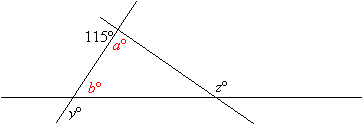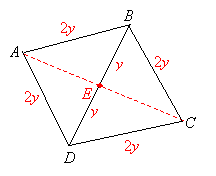

SAT Practice Test 7, Section 5: Questions 16 - 20
Related Topics:
More SAT Math Help
More SAT Preparation
This is for SAT in Jan 2016 or before.
The following are worked solutions for the questions in the math sections of the SAT Practice Tests found in the The Official SAT Study Guide Second Edition![]() .
.
It would be best that you go through the SAT practice test questions in the Study Guide first and then look at the worked solutions for the questions that you might need assistance in. Due to copyright issues, we are not able to reproduce the questions, but we hope that the worked solutions will be helpful.
16. Correct answer: (E)
Given:
The figure
To find:
y + z
Solution:
Topic(s): Supplementary angles

a = 180 –115 = 65 (supplementary angles)
z = 65 + b (exterior angle of a triangle = sum of opposite interior angles)
b = 180 – y (supplementary angles)
z = 65 + 180 – y
y + z = 180 + 65 = 245
Answer: (E) 245
17. Correct answer: (D)
Given:
The sum of 3 consecutive odd integers = 111
n is the least of the 3 integers
To find:
The equation for n
Solution:
Topic(s): Consecutive integer problems
n + n + 2 + n + 4 = 111
3n + 6 = 111
Answer: (D) 3n + 6 = 111
18. Correct answer: (A)
Given:
The figure, which shows part of a circle whose circumference is 45
The arc of length 2 and length b continue to alternate around the entire circle so that there are 18 arcs of each length
To find:
The degree measure of each of the arcs of length b
Solution:
Topic(s): Arc of circle, proportional word problem
18 arcs of each length 2 and b = 45
![]()
The length of the arc is proportional to the degree measure.
If 45 then 360º, if ![]() then how many degrees?
then how many degrees?

Answer: (A) 4º
19. Correct answer: (C)
Given:
The cost of maintenance increases by 10% each year
Andrew paid $300 for maintenance this year
The cost c for maintenance on Andrew’s automobile n years from now is given by the function: c(n) = 300xn
To find:
The value of x
Solution:
After one year, Andrew would need to pay
300 + 10% × 300
= 300 + 300(0.1)
= 300(1 + 0.1)
= 300(1.1)
After two years, Andrew would need to pay
300(1.1) + 10% × 300(1.1)
= 300(1.1) + 300(1.1)(0.1)
= 300(1.1)(1 + 1.0)
= 300 (1.1)(1.1)
= 300(1.1)2
After n years, Andrew would need to pay
300(1.1)n
Equating with the given function:
c(n) = 300xn = 300(1.1)n
Therefore, x = 1.1
Answer: (C) 1.1
20. Correct answer: (B)
Given:
The figure
The 5 line segments are congruent
To find:
The ratio of the length of ![]() to the length of
to the length of ![]()
Solution:
Topic(s): Rhombus, Pythagorean theorem

AB = BC = CD = AD =BD (The 5 line segments are congruent)
This implies that ABCD is a rhombus.

Try out our new and fun Fraction Concoction Game.
Add and subtract fractions to make exciting fraction concoctions following a recipe. There are four levels of difficulty: Easy, medium, hard and insane. Practice the basics of fraction addition and subtraction or challenge yourself with the insane level.



We welcome your feedback, comments and questions about this site or page. Please submit your feedback or enquiries via our Feedback page.


